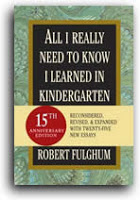As I was doing a little research for my previous post I came across this on Dr. Robert Fulghum’s website!! I love it!!! It speaks to the human side of sadness and sorrow in a way that I have never heard!! I have pasted it below and give him full credit for the amazing story he has written. If you want to read more of these, check out his website at www.robertfulghum.com
FROM THE OFFICIAL WEBSITE OF DR. ROBERT FULGHUM. CHECK OUT www.robertfulghum.com
January 21, 2010
Seattle, Washington – January 20, 2010
IT’S NOT THE SIZE OF THE LOSS,
BUT THE SIZE OF THE SORROW.
Last Saturday – out for an early morning walk.
Heavy fog – a chilly, drippy start to a January day.
Nobody else seemed to be out and about.
So quiet . . .
Until I’m a block from the nearby park.
From somewhere close by I heard the sound of a small child crying.
But the fog was so thick I couldn’t see far enough to locate the child.
The Good Samaritan Alert goes on in my mind.
Trouble? Lost? Injured? What?
Hurrying along I found, standing on a corner, these three:
A mother, a child, and a dog.
The mother was weeping.
The child was crying.
And the dog looked so forlorn it would have been in tears – if dogs did that.
All three were in basic Seattle cold-wet-weather gear, including the dog – a yellow Labrador, wearing a yellow rain slicker over most of him.
The child was bundled up and packed down inside a high-tech baby carriage that could be used as a Mars Rover if it had a motor.
All I could see of the child’s face were its eyes, awash with tears.
As I appeared out of the fog the child was the first to speak:
“Have you seen my . . . ?”
The word was lost in a sob.
“Seen what?” I asked, thinking puppy, kitty, doll, teddy bear, father?
Blankie turns out to be the operative word.
And the child is a little girl named Nelly, about four years old.
It took awhile, but between the tearful mother and Nelly, I got this story:
Once upon a time . . . Nelly’s grandmother made a blanket just for her.
Nelly became deeply attached to the blanket, as children will.
In time, the blanket became little more than a deteriorating rag.
Last summer the dog and Nelly had a tug-of-war with the blanket.
The big dog tore off a big chunk of the blanket.
The mother did not repair the blanket, thinking it was history.
Alas, Nelly remained fully committed to both parts of the blanket.
This morning the mother has been out jogging with the Nelly-in-the-bucket.
Somewhere along the way the lesser part of the blanket went overboard.
And now, despite retracing the route three times, it cannot be found.
The mother choked up again.
Nelly lapsed into sobs again.
And the dog lay down with its face in its paws.
All three were wet, cold, and approaching hysteria or hypothermia or both.
“What does the blankie look like?” I asked
“Like that . . .” said the mother, pointing at Nelly’s wrapping.
Around Nelly’s neck and head was entwined what might be the desiccated remains of a dead python.
Lumpy, fuzzy, brown and green and red, with yellow stripes here and there.
A raggedy remnant of what once was the blanket.
A blanket now in such grim shape that you might find it in the reject dumpster out behind a recycling center.
“My blankie,“ moaned Nelly, tightly clutching the dead python.
This could be funny.
And maybe . . . someday . . . it will be.
But not now.
Not to Nelly.
Or the mother.
Not even to the dog.
As the world rates catastrophes, the missing partial blankie is small stuff.
But to Nelly . . . a major loss.
I was struck by the serious dignity of her grief.
No wailing or screaming or fit-pitching.
Just sad-eyed sorrow.
“I need my blankie. . .”
What could I say or do?
Should I explain to Nelly that the Buddha said that the attachment to things is the source of sorrow? Be not attached.
Should I say to Nelly that her situation is the glass-half-full, glass half-empty
attitude problem? Be glad you still have most of the blanket.
Should I tell Nelly that life isn’t fair and that losing a partial blankie is training for future losses in life?
Shall I elaborate about hurricanes, earthquakes, fire, thieves, and the loss of a limb or sight or parents? Could be worse.
Or maybe explain to her about the losses involved in love and friendship, when what is lost is never found again?
No. Nelly is four.
Sooner or later she’ll find out on her own, like the rest of us.
Nelly’s sorrow is still real to Nelly.
And grief is to be attended to, not judged or analyzed or dismissed.
This was not the time for the Good Samaritan to offer a sympathetic discourse to mother or child or dog on the existential realities of the human condition.
Dispassionate explanations will not help.
So I knelt down beside Nelly and said,
“I’m so sorry.
I understand.
I had this happen to me once.
It made me cry, too.
I’ll look for it.
And if I find it, I’ll make sure you get it back.”
(And to my complete surprise, when I said that, tears came to my own eyes.
I’m not sure just why.
Perhaps I was thinking of the times in my life when I wish someone had said that to me when I was grieving over a loss of my own.
Lost Blankies come in many sizes and shapes and forms.)
What I said seemed to help. Not much. But some.
Enough to set the threesome in motion again on their quest.
Blocks away I found the missing semi-blankie.
Or thought I did. Several times.
In the half light of a foggy morning, many heaps of mossy trash lodged under bushes resembled partial pythons.
The false sightings reflected my hope that I could and would find Nelly’s blankie, and be the one who returned it.
But I did not and was not.
So what’s this all about?
I’ve been asking myself that for the last few days.
My frustration in this small matter mirrors, I think, a deeper universal human wish that any one of us could make things better for all those in pain wherever, whenever, no matter how small the loss or large the sorrow.

